Fantasy Baseball Draft Strategy: Why Robinson Cano Is Not a 1st- Rounder
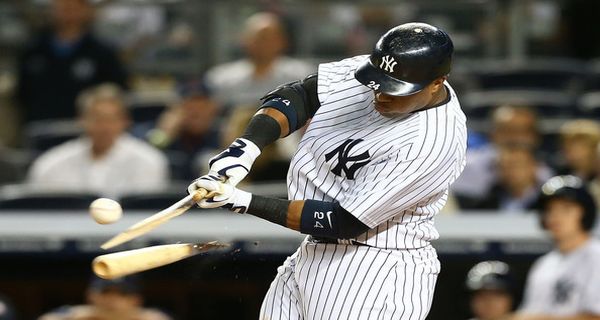
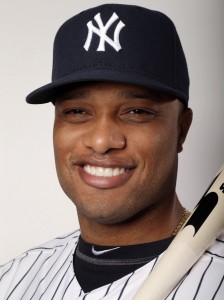
I was doing a mock draft with a buddy last night, and he had the fourth overall pick. This is probably the most interesting pick in the entire draft assuming Trout, Braun, and Miggy go one-two-three in some order. The fourth pick can go any number of ways. There are several excellent outfielders who offer a power/speed combo like Andrew McCuthcen or Matt Kemp. Or you could go the 1B route and take Albert Pujols, Prince Fielder, or Joey Votto, the only truly elite 1B options this year.
Or you could do what my buddy did and take Robinson Cano. When asked why he went with Cano his answer was obviously position scarcity. Second base is a traditionally shallow position, and Cano is the only clear elite option at the position. But is second base really shallow? And is Cano really a clear top ten player?
Depth at Second Base
Let’s start here. After Cano there is a pretty clear second tier consisting of Ian Kinsler, Dustin Pedroia, Jason Kipnis, Aaron Hill, Ben Zobrist, Brandon Phillips, and Jose Altuve. Most of those guys are decent power/speed combos and all are respectable second basemen for fantasy. If you disagree and don’t think those guys are worth owning, then you should stop reading now and just take Cano in the first.
After that things get a little tricky. Personally, I think Rickie Weeks should be in the above listed tier. Many might disagree and understandably so because of the batting average risk and his spotty health record. But Weeks is at worst a 20/10 guy with above average run totals and decent RBI totals. Absent some bad luck on balls in play, he should be able to hit .250. And Danny Espinosa has essentially been exactly that type of player over the last two years as well. Neil Walker profiles similarly just with a little less power/speed and more average.
So we’re already to ten useable guys after Cano and we haven’t considered Dustin Ackley’s upside, the potential that Dan Uggla goes back to hitting 30+ home runs, the reliability of Howie Kendrick, the massive steal potential with Emilio Bonifacio, and even the flier potential there is with Chase Utley if he can stay healthy. Again, that’s ten guys I’d feel comfortable slotting in at 2B and five more that I could at least live with. Maybe you disagree, but 2B doesn’t seem so shallow to me.
Is Cano an elite hitter?
At first glance it would appear that, yes, Cano is an elite hitter. He was the 10th rated hitter per ESPN’s player rater last year, and he was 8th in the league in wOBA and wRC+. He also posted career best marks in HR, SLG, OPS and ISO. So why is it that I seem hesitant to draft him as an elite hitter? Three reasons.
1. His batted ball profile does not indicate the sustainability of last year’s numbers.
The main reason Cano finished as a top ten hitter was his career high HR total of 33. In the three years prior he hit 25, 29 and 28 home runs. How did he take the next step? He had the highest HR/FB rate of his career with a mark of 24.1%. That was up 7% from what he did in 2011 and 10.4% from his career mark of 13.7%. He may well be able to keep his HR/FB above his career mark, but something like the 17% rate from 2011 is a more reasonable expectation. Moreover, Cano’s fly ball percentage has gone from 36.5% in 2010 to 31% in 2011 to 25.8% in 2012. If the HR/FB rate had remained at his career average, Cano would have hit 25 home runs or fewer in 2011 and 2012. Ultimately, something in the 26-29 range is more likely than Cano topping 30 again.
2. He’s 30.
It’s widely accepted at this point that second basemen age in a way that is noticeably different from players at other positions. All the way back in 2005, the witch, Nate Silver, wrote an article for Baseball Prospectus that pointed out that second basemen decline faster than normal in their thirties. The reasoning given by Silver for this early and unusual decline is that second base is this strange place where guys without the athletic ability to play other positions end up. Other guys don’t quite have the bat to play one of the typical power positions and others don’t have the arm to play third. These guys play second base because of their lack of a certain skill, not because they have a certain skill. And if Nate Silver says it, I take it as gospel. Below is a graph Silver included in his article that illustrates the different aging curve for second basemen.
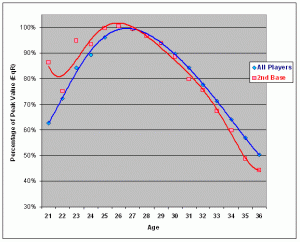
Now, this doesn’t mean Cano is going to fall off the map this season. But it does mean that there is some potential for moderate decline and essentially no upside at all. So if you’re drafting Cano somewhere between picks four through eight, you’re counting on him to repeat a career year with almost no chance he improves.
3. He struggled mightily against lefties last year.
Below are Cano’s numbers against left-handed pitchers over the last four years.
|
wOBA |
wRC+ |
ISO |
HR/FB |
K% |
|
| 2009 |
.374 |
124 |
.232 |
17.9% |
14.3% |
| 2010 |
.369 |
128 |
.229 |
17.6% |
13.0% |
| 2011 |
.375 |
134 |
.211 |
17.0% |
13.9% |
| 2012 |
.290 |
78 |
.099 |
12.5% |
17.5% |
He was clearly worse against lefties last year, but what was the cause of the problem? The easy answer might be his BABIP, which was .272 against lefties despite an excellent 28.4% line drive rate against them. He’s probably due for some positive regression in that respect, but he had a .276 BABIP against lefties in 2010 and had numbers that were similar to what he did 2009 and 2011.
The tougher answer may be that he had more trouble catching up to high heat and didn’t hit for as much power against breaking balls.
First, consider the two charts below which show Cano’s whiff rate on hard pitches (fastball, sinker, cutter) from 2011 and 2012. The first chart is from 2011 and the second chart is from 2012. As you’ll see, Cano swung and missed more on balls up in the zone which may have been the cause of the increase in K%.
Next, consider two more charts which show Cano’s ISO against breaking pitches (slider, curve) in 2011 and 2012. Again, the first chart is from 2011 and the second chart is from 2012. As you’ll see, Cano did not display the same level of power against those pitches in 2012.
To be clear, none of this means Robinson Cano is not a great player. And it doesn’t mean I don’t think he’s not worth a second round pick. But it does mean that taking him too soon after the big three might be a mistake.
You can follow Brett on Twitter @TheRealTAL.
Huge thanks to Fangraphs for the data and Baseball Prospectus for the charts.


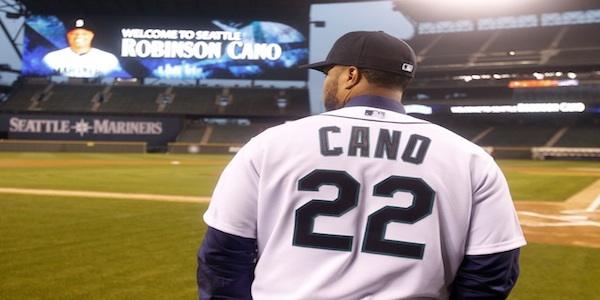
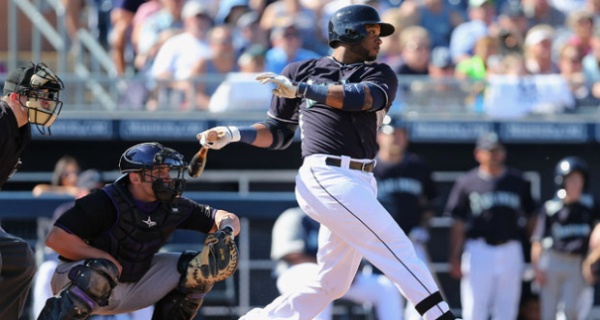
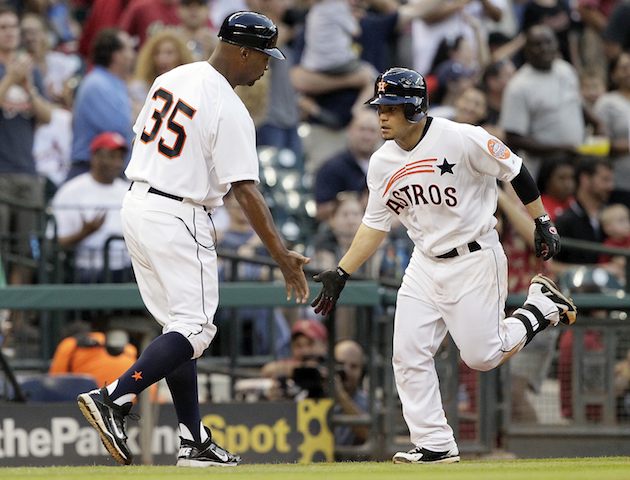
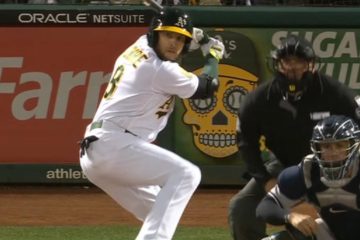
2 Comments
[…] that might be a mistake. I wrote a long piece on this topic for another site (which you can read here), but let me summarize the […]
[…] the preseason I wrote about why I didn’t think Robinson Cano was worth a first round pick. Before we look back at my […]